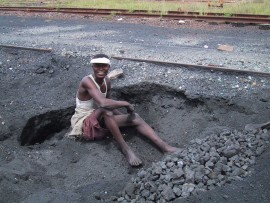Kabwe, Zambia
Pollutant: Lead
Population Affected: 300,000+
Kabwe, the second largest city in Zambia, is located about 150 kilometers north of the nation's capital, Lusaka. A 2006 health study discovered that, on average, children’s blood lead levels in Kabwe exceeded the recommended levels by five to ten times.[1] This was the result of contamination from lead mining in the area, which is situated around the Copperbelt. In 1902, rich deposits of lead were discovered, leading mining and smelting operations to run almost continuously for over 90 years without the government adequately addressing the potential dangers of lead. Smelting was largely unregulated throughout the 20th century in Kabwe, and these smelters released heavy metals in the form of dust particles, which settled on the ground in the surrounding areas.[2] While the mine is currently closed, artisanal activity at tailings piles continues.
The current CDC recommended level of lead in children’s blood is 5 ug/dL. Levels in excess of 120 ug/dL can potentially be fatal. In some neighborhoods in Kabwe, blood concentrations of 200 ug/dL or more were recorded in children, and records show average blood levels of children tested ranged between 50 and 100 ug/dL.[3] Children who play in the soil and young artisanal miners in the area are most at risk.
The Zambian government has made significant progress in dealing with the issue, particularly through a World Bank and Nordic Development Fund USD 26 million remediation program from 2003 to 2011.[4],[5] Despite these efforts, the site still poses an acute health risk that
[1] Tembo, B., K. Sichilongo, and J. Cernak. "Distribution of Copper, Lead, Cadmium and Zinc Concentrations in Soils around Kabwe Town in Zambia." Chemosphere 63.3 (2006): 497-501.
[2] IRIN: Kabwe, Africa’s Most Toxic City; 2006. Available at: http://www.irinnews.org/report/61521/zambia-kabwe-africa-s-most-toxic-city
[3] Nweke, Onyemaechi C., and William H. III Sanders. "Modern Environmental Health Hazards: A Public Health Issue of Increasing Significance in Africa." Environmental Health Perspectives (2009).
[4] The World Bank: Copperbelt Environment Project Tackles the Lead and Uranium Danger in Zambia. Available at: http://go.worldbank.org/NQ5GAPHMA0
[5] Berkeley Mineral Resources PLC: The Kabwe Mine; 2013. Available at: http://www.bmrplc.com/lead-and-zinc/kabwe-mine/




